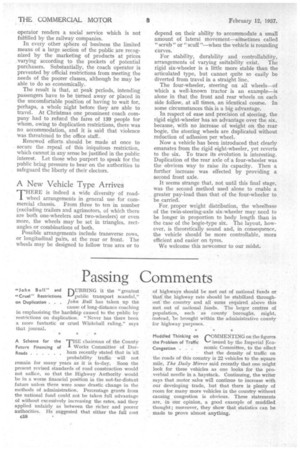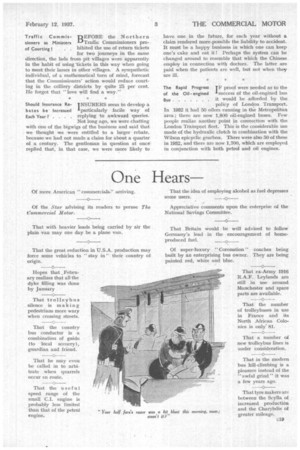Passing Comments
Page 68

Page 69

If you've noticed an error in this article please click here to report it so we can fix it.
"John Bull" and nTIBBING it the "greatest "Cruel" Restrictions 1-"public transport scandal," on Duplication . . . John Bull has taken up the
cause of long-distance coaching in emphasizing the hardship caused to the public by restrictions on duplication. "Never has there been a more fantastic or cruel Whitehall ruling," says that journal.
A Scheme for the THE chairman of the County Future Financing of 1 Works Committee of Dur
Roads ham recently stated that in all
probability traffic will not remain for many years as it is to-day. Soon the present revised standards of road construction would not suffice, so that the Highway Authority would be in a worse financial position in the not-far-distant future unless there were some drastic change in the methods of administration. Percentage grants from the national fund could not be taken full advantage of without excessively increasing the rates, and they applied unfairly as between the richer and poorer authorities. He suggested that either the full cost of highways should be met out of national funds or that' the highway rate should be stabilized throughout the country and all sums required above this met out of national funds. The larger centres of population, such as county boroughs, might, instead, be brought within the administrative county for highway purposes.
Muddled Thinking on rOMMENTING on the figures
the Problem of Traffic issued by the Imperial ,co
Congestion . . . nomic Committee, to the effect
that the density of traffic on the roads of this country is 22 vehicles to the square mile, The Daily Mirror said recently that one might look for these vehicles as one looks for the proverbial needle in a haystack. Continuing, the writer says that motor sales will continue to increase with our developing trade, but that there is plenty of room for many more vehicles in the country without causing congestion is obvious. These statements are, in our opinion, a good example of muddled thought; moreover, they show that statistics can be made to prove almost anything. Traffic CommisEFORE the Northern sioners as Ministers "Traffic Commissioners proof Courting ! . • . hibited the use of return tickets for two journeys in the same direction, the lads from pit villages were apparently in the habit of using tickets in this way when going to meet their lasses in other villages. A sympathetic individual, of a mathematical turn of mind, forecast that the Commissioners' action would reduce courting in the colliery districts by quite 25 per cent. He forgot that " love will find a way."
Should Insurance ReINSURERS seem to develop a bates be Increased lparticularly facile way of Each Year replying to awkward queries.
Not long ago, we were chatting with one of the bigwigs of the business and said that we thought we were entitled to a larger rebate, because we had not made a claim for about a quarter of a century. The gentleman in question at once replied that, in that case, we were more likely to have one in the future, for each year without a claim rendered more possible the liability to accident. It must be a happy business in which one can keep one's cake and eat it I Perhaps the system can be changed around to resemble that which the Chinese employ in connection with doctors. The latter are paid when the patients are well, but not when they are ill.
The Rapid Progress IF proof were needed as to the of the Oil engined "success of the oil-engined bus
Bus it would be afforded by the policy of London Transport. In 1932 it had 50 oilers running in the Metropolitan area ; there are now 1,800 oil-engined buses. Few people realize another point in connection with the London Transport fleet. This is the considerable use made of the hydraulic clutch in combination with the Wilson epicyclic gearbox. There were also 50 of these in 1932, and there are now 1,700, which are employed in conjunction with both petrol and oil engines.




























































































































































